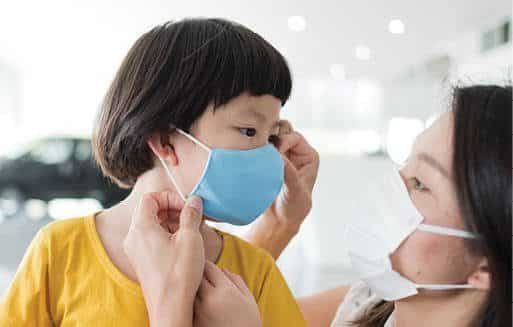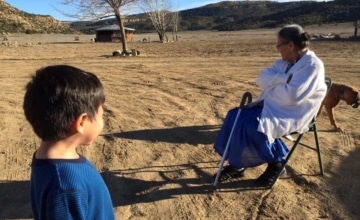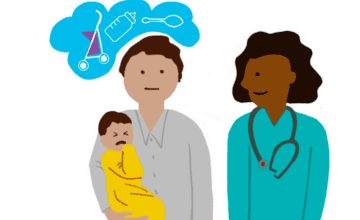Kristyn Wong, Jessica L. Riggs, and Megan M. Julian, Michigan Medicine, Ann Arbor, Michigan; Alissa C. Huth-Bocks, Rainbow Babies and Children’s Hospital, University Hospitals Cleveland Medical Center, Cleveland, Ohio; Maria Muzik and Katherine L. Rosenblum, Michigan Medicine, Ann Arbor, Michigan; and Michigan Collaborative for Infant Mental Health Research, University of Michigan

Abstract
The impact of COVID-19 stressors on young children and families may differ based on pre-pandemic factors, including family race/ethnicity, financial stability, and pre-existing child developmental or social–emotional difficulties. The authors draw from their work with families with toddlers and preschool-aged children to explore experiences of the pandemic on families and how perceived stress has changed over time. They also demonstrate unique experiences of families by examining the impact of COVID-related stress across race. Addressing areas where additional supports are likely needed to support families with young children is a focus.
In March 2020, the COVID-19 pandemic changed everyday life for young children and families in the United States. At the time of this writing, the disease itself has led to over 5.2 million deaths worldwide (World Health Organization, 2021), with more than 900,000 of those in the United States alone (Centers for Disease Control and Prevention, 2021). It is estimated from observational modeling that over 140,000 children in the U.S. experienced the death of a parent or grandparent caregiver from April 2020 to June 2021 (Hillis et al., 2021). In addition to the staggering death toll, COVID-19 has had detrimental impacts on all aspects of society; burdening health care systems, challenging government infrastructures, and stunting economic growth. At the community level, restrictions to limit the spread of COVID-19 have led to significant school closures and staff shortages, stretched community resources thin, and shuttered small businesses. After nearly 2 years, the pandemic continues to overwhelm and divide communities, and yet the supports to negate the effects of this pandemic for young children and their families still lag behind.
As society begins to settle and adapt to a new “normal,” the pandemic has clear negative impacts on the mental health and psychological well-being of children and their families. Caregivers report experiencing worsening mental health symptoms, higher levels of perceived stress, increased alcohol consumption and parental burnout; for children, caregivers also report increased rates of child stress and worsening child behavioral health (Gadermann et al., 2021; Kerr et al., 2021; Patrick et al., 2020; Russell et al., 2020).
Early childhood represents a critical time in which relational experiences set the foundation for later optimal child development. The pandemic has and continues to confer both direct and indirect stress related to COVID-19, leading to multiple risk factors with cumulative negative effects on young children and their families (Liu & Doan, 2020; Prime et al., 2020). Experiencing chronically high levels of stress and adversity in the early childhood years has long-standing consequences for later physical and psychological well-being into adulthood (Shonkoff et al., 2012). Yet, in the midst of this pandemic, most of the research examining the impacts of COVID-19 on child development, caregiving, and stress has been conducted via online questionnaires with caregivers of children ranging in age from birth to 18 years old (Kerr et al., 2021; Patrick et al., 2020; Russell et al., 2020). Few studies have focused on in-depth examinations of the consequences of this pandemic specific to caregivers of infants, toddlers, and preschoolers who may be uniquely impacted due to the developmental needs of this age group. This work is imperative to help identify the most effective ways to support early positive development and mitigate risk during the ever-changing landscape of the COVID-19 pandemic.
Early in the pandemic, it was clear that there were disproportionate impacts on women who quickly shifted to take on significant caregiving roles due to early childhood education and school closures on top of basic domestic and household tasks they were already responsible for (Alon, et al., 2020; Power, 2020). The impact of these changes contributed to 2.4 million American women leaving the workforce from February 2020 to February 2021 (Pew Research Center, 2021). Many families continue to struggle with the economic burden of businesses closing or caregivers’ job loss, jeopardizing stable living conditions and access to necessities. The compounding social and economic effects of COVID-19 have been far more dire for families of color, who are also significantly impacted by health disparities that are historically linked to structural racism and discrimination in the United States and continue to devastate their communities (Cooper & Williams, 2020).
In this article, we draw on our work with parents of toddlers and preschool-aged children to gain a deeper understanding of their felt experiences in response to the COVID-19 pandemic. The data discussed in this article come from a larger, longitudinal study testing the efficacy of the Infant Mental Health Home Visiting intervention (Lawler et al., 2017; Ribaudo et al., 2022; Riggs et al., 2021). Parents provided us with information about their own perceived stressors, as well as their perceptions of how their young children were responding to the pandemic and related changes. We collected information about the impacts of the pandemic on family health, finances, and social interactions. In addition, we inquired about experiences of racism and discrimination which, for some families, contributed to added stress and worry. Overall, these responses shed light on the resiliency and vulnerability of families during the COVID-19 pandemic. Here, we present common themes that emerged from our research and conversations with families. We also discuss specific factors that might increase difficulties and stress for some families, and we describe potential ways to provide support as the impacts of the pandemic persist.
Parent Stress in Response to COVID-19: Initial Reports
Parents who provided responses about their families’ experiences related to COVID-19 were mothers who had participated in a study examining the impact of home-visiting therapy services on family functioning (see Box 1). These families experienced various challenges prior to the start of the pandemic which may have increased their vulnerability to COVID-related stress, including low family income resulting in eligibility for public assistance (63.01%), elevated symptoms of maternal depression (41.10%), maternal experiences of childhood adversity (67.12%), and/or challenges related to parenting or understanding child behavior (69.86%). Among the group, there was diversity in family race/ethnicity and family income, allowing us to evaluate reports of COVID-related stress among families with unique sociodemographic backgrounds (see Table 1).
Box 1. Participants and Methods
This box describes study eligibility criteria and methods for participant recruitment.
- To be eligible for this study, mothers had to be ≥18 years old, they needed to have legal custody of their child who would also be enrolled in the study, and their child had to be <25 months old at the time of study enrollment.
- Exclusion criteria included parental symptoms of psychosis or substance use disorders.
- Additional inclusion criteria ensured similarity between the study sample and those typically receiving Infant Mental Health Home Visiting services in the community. Inclusion criteria included: eligible for public assistance, probable maternal depression, maternal history of childhood adversity, difficulty with parenting.
- Participants were recruited via flyers placed at community locations that were likely to be frequented by eligible families. In addition, some participants were recruited via a local birth registry, where new mothers indicated interest in being contacted for future research opportunities.
- A total of 422 mothers were screened for participation in the study. Of those, 281 were not eligible, 62 were not interested, and 5 were eligible and interested but never enrolled. This resulted in 73 eligible and enrolled. For this article, the results are from 53 of the 73 eligible participants who completed at least one COVID interview.
- Interviews were conducted in person, via video conference, or over the telephone due to COVID protocols.
- Table 1 provides participant demographics. Mothers reported their race and ethnicity at study entry; 69.90% reported their race as White, 32.90% reported their race as Black or African-American, and 15.07% reported their race or ethnicity as something else. Mothers also reported their child’s race/ethnicity; 72.60% of children in the study were White, 37.00% were Black/African-American, and 28.77% were reported by their mothers to have a different race or ethnicity.
Table 1. Participant Demographic Data
Note: Participants were encouraged to choose all race/ethnicity categories that applied, meaning total frequencies are greater than 100%.
Our first interviews with mothers occurred in June 2020, approximately 3 months after the start of the COVID-19 pandemic in the United States, and well after there had been widespread impacts across the country, including school and early childhood education center closures, record high rates of unemployment, and significant fatigue settling in among health care and other “essential” workers. During this interview, we asked mothers about their experiences with many possible stressors using a standard format and asked open-ended questions to hear about the personal and unique experiences of families. Of the standard question responses, the stressors reported to cause the most distress to mothers spanned financial, health, and social domains. Worries related to loss of job or decrease in family income were rated quite high during this interview, indicating increased financial stress for many families. Parents also endorsed stressors related to physical and mental health, including worries about contracting COVID-19, increased feelings of anxiety or depression, worries about changes in child behaviors, loss of social connections, and feelings of social isolation. Other highly rated stressors included things that may disproportionately impact women and/or mothers, including loss of early childhood education, increased responsibilities to care for children who might otherwise be in school, and stress about balancing work with other, home-based responsibilities.
Examining the open-ended responses revealed several themes as well. Some stressors were embedded in family relationships. Co-parenting, with a current or former romantic partner, as well as parenting exchanges for separated couples, was mentioned by many mothers. Others referenced feeling worried due to increased marital problems. One mother, who was partnered at the time of the interview, noted that she had concerns about disagreements between individuals in her home. She reported “feeling trapped and not being exactly sure what I would do if things became too volatile here.” Such a report exemplifies worries many public health and mental health providers have had during the COVID-19 pandemic regarding increased rates of violence or abuse within the home.
For others, navigating the pandemic while pregnant was named as a cause of worry. These worries included concerns about delivering a baby at a hospital when there were restrictions about who could accompany a mother during delivery. Mothers also had concerns about the health of a baby who may be exposed to COVID-19 in utero, or shortly after birth. While some moms reported concerns about their unborn children, others expressed worries about their toddlers or preschool aged children. One mother reported that she lives near a community playground and stated, “It’s been hard to keep our kids separated from other kids coming around.” For others still, virtual learning and working to keep children engaged with educational material was reported as a major stressor.
Another theme that emerged from open-ended responses during this first interview included concerns about the public health behavior of others. Several mothers reported feeling stressed in relation to others not wearing masks, or protesting government-mandated shutdowns of certain businesses. Others specified that differences in safety precautions within families was a major stressor. One mother reported that her “in-laws have different mindsets about precautions, which is leading to family turmoil and drama and conflict—others feel that we are being too cautious…” Another mother reported that she felt as though others treated her disrespectfully because she had contracted COVID-19, indicating that there may have been judgements and assumptions from others about what she did or did not do with regard to safety precautions.
Some participants also highlighted structural barriers that were faced during the pandemic. For example, one mother expressed difficulty obtaining a doctor’s appointment when she was sick (non-COVID related) and noted the limitations of virtual care options. Others expressed frustration with governmental responses to the pandemic and expressed worry that the pandemic was not taken as seriously by political leaders as it should have been.
A final theme that emerged from interview responses early on was an awareness of the compounding effect of the COVID-19 pandemic with racism and discrimination experienced by persons of color. One mother noted “I worry/think about my husband (who is Black) feeling stress about wearing a mask in public.” Another mother acknowledged the stress of racial disparities, noting that she worries about her Black teenage son and husband. White mothers also addressed stress related to knowledge of racism. One mother reported her realization that she had privilege as a White person and reported feeling “meta-stress” in her path to commit to antiracism.

Mothers had concerns about the health of a baby who may be exposed to COVID-19 in utero, or shortly after birth. Photo: shutterstock/TommyStockProject
Across all interview responses from this early look into the impact of COVID-19, it was clear that families with very young children were experiencing difficulties across domains. Also, it was clear that the impact of COVID-19 was not experienced the same way by all and that social and demographic factors likely exacerbated worry for many.
Parent Stress in Response to COVID-19: Follow-Up Reports
We engaged in follow-up interviews with families, with the goal of understanding how COVID-related stress was changing over time. We completed up to three additional interviews with mothers over the next several months, and we examined changes in reported stressors across these interviews.
Some stressors were consistently rated as concerning, including the stress of balancing work with home responsibilities and taking care of children who would otherwise be in school or early childhood education settings. Other stressors changed over time. There were increases in concerns related to mental and behavioral health within the family. There was a clear pattern of increased worries about heightened anxiety and depression across interviews. We found it interesting that worries that were not initially rated high, including stress related to past trauma reminders, became more commonly endorsed over time. Parents’ concerns about children’s behavior problems also increased across assessments.
While there was an increase in mental and behavioral health related concerns, overall, concerns about financial stressors decreased across interviews. In particular, both worries related to running out of food or other goods and worries about losing work or loss of family income decreased. When reviewing open-ended responses of COVID-related stress at the follow-up interviews, many of the top stressors remained the same for parents. These top stressors included reported difficulties within romantic relationships, including two mothers reporting that they had separated from their partner during the time between interviews. Stress related to the precautions taken or not taken by others also remained high, with concerns expressed about others wearing masks, and plans for school and early childhood education program re-openings toward the end of the year, and concerns about the safety of practices for children. Despite these worries, others expressed frustration about not being able to do things with their children outside of the home. One mother reported feeling overwhelmed by not being able to take her child out and to activities and noted that she and her family had already contracted COVID-19, and therefore remaining home felt like an unnecessary precaution, given the small chance of re-contracting COVID-19 in a short time span.
Other stressors that remained high for many included stress related to experiences of racism and discrimination, for oneself or for one’s loved ones. Non-White mothers continued to report worries for themselves, their husbands, and their children regarding experiences of racism, including safety in their communities. One mother noted “[My] husband is not White and works retail. [I] worry for him.” Some White mothers continued to grapple with their own privilege and with the realization that non-White families were experiencing intense racism and discrimination at a personal and systemic level.
Notably, fewer concerns related to barriers in health care were expressed in the open-ended questions across later interviews. It may have been that families were adjusting to hybrid models of health care, or it may have been that some barriers for in-person appointments had lessened as time went on. Regardless, it appears as though scaffolded support provided by health care agencies may have been better meeting the needs of families as the pandemic progressed.
Infant/Toddler Behavior in Response to COVID-19: Initial Reports and Changes Over Time
Across all interviews, changes in child behavior/increases in child behavior problems was rated as a top stressor for many parents. We also asked mothers to tell us about specific changes in child behavior using a structured interview assessment. During the first interview, some mothers reported that their young children were having more temper tantrums, were crying more frequently, and were engaging in more “clingy” behaviors. We were intrigued that mothers noted that their children’s behavior remained as playful as at the start of the pandemic.
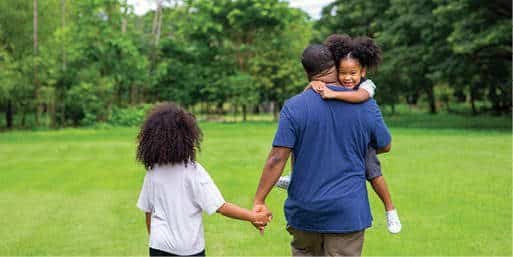
Non-White mothers continued to report worries for themselves, their husbands, and their children regarding experiences of racism, including safety in their communities. Photo: shutterstock/CandyRetriever
There were some changes in these reports of toddler behavior problems over time. Some parents noted that problems decreased over time. For example, reports of children crying more frequently peaked during the second interview, and then decreased across later interviews. Other problems increased over time. For example, children being viewed as more withdrawn by their parents was rated low during the first interview. However, reports of children being more withdrawn increased over time at each subsequent interview, suggesting that young children’s behavioral responses to COVID may have shifted over time to a more internalizing or withdrawn presentation.
Mothers also responded to open-ended questions about how their young child’s behavior has changed in response to the pandemic. Several responses commented on positive changes in response to the pandemic, including increased time and connection with family members, ability to make friends with peers in the neighborhood, and general positive adjustment. However, many parents noted specific concerns, which are explored in the following paragraphs.
Similar to parent responses of their own stress, one theme related to child reactions to COVID-19 was associated with changes in relationships. Many parents reported that their child is “grumpier” with their family members or that their behaviors have shifted in response to the additional stress that other family members were experiencing. Many other responses addressed the increased anxiety that children were experiencing, often in response to worries about contracting or spreading COVID-19. For example, one mother said that their child experienced “…increased anxiety from the pandemic itself and its impact on adults,” while another parent noted that their child was worried about leaving the home and contracting “the sickness.”
In addition to relational and emotional reactions, parents also noted that their young children experienced regressions and disruptions in their schedules. Many responses across all interview timepoints mentioned regressions in toilet-training, disruptions in sleep schedules (and associated behavioral difficulties), and changes in appetite and/or weight gain. These concerns underscore the changes to toddler and preschool-aged children’s regulatory systems in response to COVID, and they highlight additional and diverse supports that families may benefit from.
Socio-Demographic Intersection With COVID-19–Related Stress: Parents
Mothers’ experiences of COVID-related stress differed depending on some pre-pandemic family factors. Specifically, family income was linked with perceived stress in many areas. For example, mothers with lower income reported experiencing stress about paying for housing or utilities more than mothers with higher incomes. Whereas, higher income mothers were more likely to describe stress related to accessing mental health services. Other experiences differed by family income in less predictable ways. For example, families with lower incomes reported more stress associated with wearing a mask or other coverings in public compared to more affluent families. This may have been because lower income families were in public more often; perhaps to use public transportation or to engage in work in essential service fields. Another unexpected finding was that higher-income families reported more stress associated with tension or conflict among household members. This finding may be partially confounded by relationship status, wherein mothers with lower incomes may be less likely to have an adult partner living in the home, contributing to family income. Therefore, they may have fewer opportunities to have tension or conflict with another. However, this is likely not the entire story, as there was no association between parent relationship status and stress related to conflict or tension in the home.
Socio-Demographic Intersection With COVID-19–Related Stress: Children
We also found in our interviews with families that there were some pre-pandemic family factors that were associated with more changes in young child behavior. Family income was one such factor. In particular, families who reported earning less money reported that their children experienced more behavior changes at each interview, including increased reports of crying, withdrawn behaviors, clinginess toward parents, and temper tantrums. This finding suggests that children with less economic stability or privilege may have had fewer buffers between themselves and various aspects of the COVID-19 pandemic, resulting in a bigger shift in behaviors. Alternatively, or in addition, parents with more financial stress may perceive their children as engaging in more problematic behaviors, given the compounding stressors of financial worries and child social–emotional and behavior problems. Regardless of the underlying cause, our conversations with families suggest that additional support for young children and their parents may be especially important among lower income families.
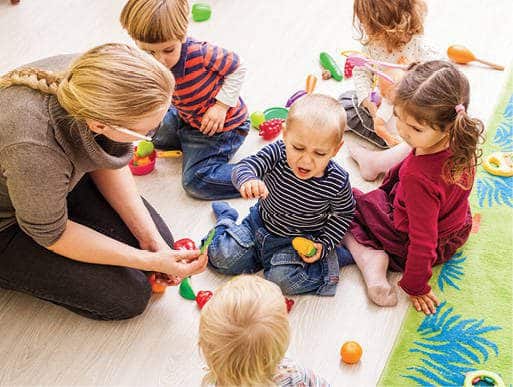
During the first interview, some mothers reported that their young children were having more temper tantrums, were crying more frequently, and were engaging in more “clingy” behaviors. Photo: shutterstock/Oksana Shufrych
In addition to differences related to family finances, pre-pandemic child social–emotional problems were also associated with increased parent reports of child behavior changes in response to the pandemic. Specifically, prior to the pandemic, parents reported on their toddlers’ social and emotional behaviors on a standard symptom screening measure. There was a moderate association between elevated problems reported prior to the COVID-19 pandemic and reports of problematic behavior changes during the pandemic. This result suggests that children who may have been struggling prior to the pandemic were likely to have the worst adjustment to the immense changes that COVID-19 brought about. This also highlights that some of the seeming adjustment to COVID-related stress exhibited by toddlers may be linked to pre-existing vulnerability for more lasting social, emotional, and behavioral problems. These children who were not faring well prior to the pandemic may need more intensive support or intervention as the pandemic continues to progress.
Intersection of COVID-19–Related Stressors and Family Race
As most know, the COVID-19 pandemic overlapped with an increased awareness of racial inequities experienced by people of color. This fact is highlighted in some of the responses we discussed above, including increased awareness of racism and increased stress and worry about family members within non-White families. We wanted to systematically assess whether some stressors were more acutely experienced by some families, based on family race and ethnicity. Our results suggest that stress associated with COVID-19 was uniquely related to race, further highlighting existing inequities.
It was not surprising that non-White families reported significantly more stress related to experiencing discrimination based on their race and on their income status. They also reported more worries associated with being arrested, detained, or experiencing violence from the police, compared to White families. Fear of discrimination extended into health care settings, with non-White mothers reporting more stress associated with being denied health care compared to White mothers. This finding is especially important considering the careful attention being paid to structural racism within health care systems, during a time when trust in the medical system is vital for increasing access to care and increased vaccination rates.
Other differences in perceived parental stress by race or ethnicity were found. Families of color were more likely to experience stress regarding paying for housing or utilities, compared to White families, underscoring the association between race and income. Other differences suggested that non-White families experienced less social or relational stress than White families. For example, White families were more likely to report stress associated with increased tension or conflict at home, and they reported greater worries associated with social isolation. This result may be linked to greater social connection and intergenerational support in families of color. Children’s behavior did not vary much on the basis of family race or ethnicity. During some interviews, White mothers were slightly more likely to describe that their young child was more withdrawn, compared to non-White mothers. Also, during the last interview, non-White mothers reported more instances of their young child crying, compared to White mothers. Considering that among the overall group, rates of crying seemed to decrease by the last interview, it is notable that this was not necessarily the case for children of color.
Conclusions
The pandemic has led to significant disruptions in daily life which in turn have contributed to increased COVID-related stress for both parents and young children. Early in the pandemic, parents we talked to expressed worries spanning all domains of life including financial, social, and physical/ mental health. At follow-up assessments many of those worries remained the same regarding financial well-being, balancing caregiving and household responsibilities, racism/ discrimination, and concerns around others’ public health behavior. However, it was notable that concerns regarding mental and behavioral health of the whole family dramatically increased across the pandemic. At the onset of the pandemic, parents reported increased behavioral difficulty in their young children including more temper tantrums, crying, and clinginess. However, as the pandemic has progressed, parents have reported that child behavior has shifted to be more withdrawn and internalizing behavior over time. This shift may be in part due to the different types of stress experienced by parents across the pandemic. The stress contagion perspective in the context of the COVID-19 pandemic (Liu & Doan, 2020) is useful for thinking about why these shifts may occur. The idea of stress contagion highlights two concepts. The first is stress spillover, which describes the phenomena in which stressful experiences in one domain of functioning (e.g., parent job-related stress) spill over and impact another area of functioning (e.g., engaging in responsive parenting). On the other hand, stress crossover effects highlight how stress levels in one person (i.e., parent or caregiver) impact stress experienced by another person in the home (i.e., partner or child). Early in the pandemic, caregivers were adjusting to abrupt changes to their jobs and careers including working from home while managing children who would otherwise be at early childhood education programs/school, furloughs, and layoffs. These sudden changes likely contributed to increased stress and changes in parenting behavior. As the pandemic progressed, parents likely adapted, albeit maladaptively with increased symptoms of depression and anxiety and these may have “crossed over” to children, leading to increased internalizing behavior themselves.
The pandemic has clearly exacerbated the need for additional behavioral and mental health resources for parents and young children. Our findings highlight the critical need for services that support parents in navigating increased child behavioral difficulties and managing parents’ own stress throughout the pandemic. Even more so, our work suggests that families of color and those experiencing structurally driven inequities prior to the pandemic are at even greater risk for increased stress related to meeting basic needs (i.e., access to food, shelter, heat), physical health concerns, and racism.
In line with the work of others, our findings clearly highlight that COVID-19 has magnified the social and economic inequities for families of color with young children. The intersection of stress related to the pandemic and racism/discrimination that these families have experienced has led to increases in cumulative stress. The disproportionate effects of the pandemic on families of color continue to compound the pre-existing negative effects on social, physical, and economic well-being for this population. Finding effective ways to support young children exposed to multiple stressors related to social class, income, and racism is necessary for ameliorating the psychological, emotional, and physical consequences which accompany this exposure.
Author Bios
Kristyn Wong, PhD, is a developmental psychologist who works within the Zero to Thrive program at the University of Michigan. Her research focuses on supporting early caregiving relationships and promoting the optimal socio–emotional development of young children within the context of family risk.
Jessica L. Riggs, PhD, is clinical psychologist and assistant professor of psychiatry at the University of Michigan where she conducts research and clinical work as part of the Zero to Thrive program and within the Infant and Early Childhood and Perinatal Clinics. Her work focuses on promoting early relational health for young children and their families.
Megan M. Julian, PhD, is an assistant professor of psychiatry and licensed clinical psychologist at the University of Michigan. Her current research focuses on how early relational care affects the course of development and how relationships can be enhanced to support children’s development. She has clinical expertise in the assessment and treatment of young children (ages birth-6) and their parents, and sees patients through University of Michigan’s Infant and Early Childhood Clinic.
Alissa C. Huth-Bocks, PhD, is a licensed clinical psychologist and professor of pediatrics and psychiatry at University Hospitals Rainbow Babies & Children’s Hospital. She has conducted research and trained others in the provision of maternal–infant mental health services (pregnancy through 3 years post-birth) and is endorsed as an Infant Mental Health Specialist (IMH-E Research/Faculty). She helps to develop innovative trauma-informed multigenerational primary prevention and intervention programs to address mental health and other adverse outcomes related to adversity and trauma exposure.
Maria Muzik, MD, MSc, is a psychiatrist and associate professor of psychiatry and of obstetrics and gynecology at the University of Michigan. She co-directs the Zero to Thrive program and the Women and Infants Mental Health Program. Her research focuses on two-generation interventions to promote positive parent–infant mental health.
Katherine L. Rosenblum, PhD, is a clinical and developmental psychologist and professor of psychiatry and of obstetrics and gynecology at Michigan Medicine at the University of Michigan, where she co-directs the Zero to Thrive program and the Infant and Early Childhood Clinic. Her research and clinical work focus on strength-based interventions to promote relational health and strengthen resilience in families with young children who have faced disruption and adversity.
Suggested Citation
Wong, K., Riggs, J. L., Julian, M. M., Huth-Bocks, A. C., Muzik M., Rosenblum, K. L., and Michigan Collaborative for Infant Mental Health Research. (2022). COVID-19–related stressors in parents and toddlers: Changes in mothers’ perceptions over time. ZERO TO THREE Journal, 42(3), 53–60.
References
Alon, T. M., Doepke, M., Olmstead-Rumsey, J., & Tertilt, M. (2020). The impact of COVID-19 on gender equality (Working Paper No. 26947). National Bureau of Economic Research. link. link.
Centers for Disease Control and Prevention. (2021). COVID dashboard. link
Cooper, L. A., & Williams, D. R. (2020). Excess deaths from COVID-19, community bereavement, and restorative justice for communities of color. Journal of American Medical Association, 324(15), 1491–1492.
Gadermann, A. C., Thomson, K. C., Richardson, C. G., Gagné, M., McAuliffe, C., Hirani, S., & Jenkins, E. (2021). Examining the impacts of the COVID-19 pandemic on family mental health in Canada: Findings from a national cross-sectional study. BMJ Open, 11(1), e042871.
Hillis, S. D., Blenkinsop, A., Villaveces, A., Annor, F. B., Liburd, L., Massetti, G. M., Demissie, Z., Mercy, J. A., Nelson III, C. A., Cluver, L., Flaxman, S., Sherr, L., Donnelly, C. A., Ratmann, O. & Unwin, H. J. T. (2021). COVID-19–associated orphanhood and caregiver death in the United States. Pediatrics, 148(6), e2021053760. link
Kerr, M. L., Fanning, K. A., Huynh, T., Botto, I., & Kim, C. N. (2021). Parents’ self-reported psychological impacts of COVID-19: Associations with parental burnout, child behavior, and income. Journal of Pediatric Psychology, 46(10), 1162–1171.
Lawler, J. M., Rosenblum, K. L., Muzik, M., Ludtke, M., Weatherston, D. J., & Tableman, B. (2017). A collaborative process for evaluating infant mental health home visiting in Michigan. Psychiatric Services, 68(6), 535–538.
Liu, C. H., & Doan, S. N. (2020). Psychosocial stress contagion in children and families during the COVID-19 pandemic. Clinical Pediatrics, 59(9–10), 853–855.
Patrick, S. W., Henkhaus, L. E., Zickafoose, J. S., Lovell, K., Halvorson, A., Loch, S., Letterie, M., & Davis, M. M. (2020). Well-being of parents and children during the COVID-19 pandemic: A national survey. Pediatrics, 146(4), e2020016824.
Pew Research Center. (2021, April 14). U.S. labor market inches back from the COVID-19 shock, but recovery is far from complete. Pew Research Center, link
Power, K. (2020). The COVID-19 pandemic has increased the care burden of women and families. Sustainability: Science, Practice and Policy, 16(1), 67–73.
Prime, H., Wade, M., & Browne, D. T. (2020). Risk and resilience in family well-being during the COVID-19 pandemic. American Psychologist, 75(5), 631–643. link
Ribaudo, J., Lawler, J. M., Jester, J. M., Riggs, J., Erickson, N. L., Stacks, A. M., Brophy-Herb, H. E., Muzik, M., & Rosenblum, K. L. (2022). Maternal history of adverse experiences and PTSD symptoms impact toddlers’ early socioemotional wellbeing: The benefits of infant mental health-home visiting. Frontiers in Psychology, 6168. link
Riggs, J. L., Rosenblum, K. L., Muzik, M., Jester, J., Freeman, S., Huth-Bocks, A., Waddell, R., Alfafara, E. A., Miller, A. L., Lawler, J. M., Erickson, N. L., Weatherston, D., Shah, P., Brophy-Herb, H. E., & the Michigan Collaborative for Infant Mental Health Research. (2021). Infant mental health home visiting mitigates impact of maternal adverse childhood experiences on toddler language competence: A randomized controlled trial. Journal of Developmental & Behavioral Pediatrics. doi: 10.1097/ DBP.0000000000001020. link
Russell, B. S., Hutchison, M., Tambling, R., Tomkunas, A. J., & Horton, A. L. (2020). Initial challenges of caregiving during COVID-19: Caregiver burden, mental health, and the parent–child relationship. Child Psychiatry & Human Development, 51(5), 671–682.
Shonkoff, J. P., Garner, A. S., Siegel, B. S., Dobbins, M. I., Earls, M. F., McGuinn, L., Pascoe, J., Wood, D.L., & the Committee on Early Childhood, Adoption, and Dependent Care. (2012). The lifelong effects of early childhood adversity and toxic stress. Pediatrics, 129(1), e232–e246.
World Health Organization. (2021). COVID-19 dashboard. link

